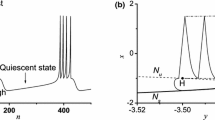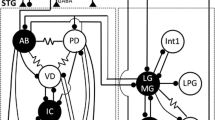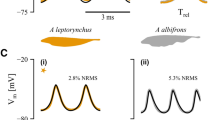Summary
-
1.
The pyloric rhythm of the lobster (Panulirus interruptus, Palinurus vulgaris) stomatogastric ganglion is generated by a set of 3 electrically coupled endogenously bursting neurons. The phasic coordinating effects of monosynaptic excitatory (EPSP) and inhibitory (IPSP) inputs to these neurons were examined in isolated nervous systems.
-
2.
Periodic stimulation of both inputs at frequencies near the endogenous frequency of the pacemakers can produce large cycle by cycle variations in the burst period of the system (Fig. 4). Similar variation in PD burst period is also observed in intact freely behaving animals (Fig. 2).
-
3.
The effect of both inputs depends on the phase at which they occur in the endogenous pacemaker cycle. Both EPSP's and IPSP's can advance or delay subsequent bursts. The two inputs exhibit qualitatively different characteristic phase response curves (Figs. 5, 6).
-
4.
Both EPSP's and IPSP's can entrain the endogenous rhythm (Figs. 7, 8). The coordinating effects of EPSP's are stronger when their repetition frequency is slightly higher than the endogenous pacemaker frequency, while those produced by IPSP's are stronger when the repetition frequency of the input is slightly slower than the repetition frequency of the oscillator.
-
5.
The phase relationships of the discharge of the pacemakers in the stimulus cycle are qualitatively different when the cyclic stimulus is slower or faster than the endogenous rhythm for both types of inputs (Fig. 9). The entrainment of the oscillator by EPSP inputs which repeat at a frequency which is greater than the endogenous frequency can be attributed to the input triggering the burst of spikes at a fixed latency (Fig. 10).
Similar content being viewed by others
Abbreviations
- IVN :
-
inferior ventricular nerve
- LP :
-
lateral pyloric motor neuron
- PD :
-
pyloric dilator motor neuron
- PY :
-
pyloric motor neuron
- VD :
-
ventricular dilator motor neuron
References
Arvanataki, A., Chalazonitis, N.: Electrical properties and temporal organization in oscillatory neurons. In: Symposium on neurobiology of invertebrates. Salanki, J. (ed.), pp. 169–199. Budapest: Akademiai Kiado 1967
Aschoff, J.: Crcadian clocks. Amsterdam: North-Holland Publishing Co. 1965
Ayers, J.L., Clarac, F.: Neuromuscular strategies underlying different behavioral acts in a multi-functional crustacean leg joint. J. comp. Physiol.128, 81–94 (1978)
Ayers, J.L., Davis, W.J.: Neuronal control of locomotion in the lobster. I. Motor programs for forward and backward walking. J. comp. Physiol.115, 1–23 (1977)
Ayers, J.L., Selverston, A.I.: Synaptic control of an endogenous pacemaker network. J. Physiol. (Paris)73, 453–461 (1977)
Barker, J.L., Gainer, H.: Studies on bursting pacemaker potential activity in molluskan neurons. I. Membrane properties and ionic contributions. Brain Res.84, 461–477 (1975)
Barnes, W.J.P.: Leg coordination during walking in the crab,Uca pugnax. J. comp. Physiol.96, 237–252 (1975)
Chalazonitis, N.: Effects of changes in pCO2 and pO2 on rhythmic potentials from giant neurons. Ann. New York Acad. Sci.109, 458–479 (1963)
Dando, M., Selverston, A.I.: Command fibers from the supraesophageal ganglion to the stomatogastric ganglion inPanulirus argus. J. comp. Physiol.78, 138–175 (1972)
Davis, W.J.: Organizational concepts in the central motor networks of invertebrates. In: Neural control of locomotion. Herman, R.M. et al. (eds), pp. 265–292. New York: Plenum Press 1976
Davis, W.J.: Quantitative analysis of swimmeret beating in the lobster. J. Exp. Biol.48, 643–662 (1968)
Eckert, R., Lux, H.D.: A voltage-sensitive persistant calcium conductance in neuronal somata ofHelix. J. Physiol.254, 129–151 (1976)
Enright, J.T.: Synchronization and ranges of entrainment. In: Circadian clocks. Aschoff, J. (ed.). Amsterdam: North-Holland Publishing Co. 1965
Evoy, W.H., Fourtner, C.R.: Crustacean walking. In: Control of posture and locomotion. Advances in behavioral biology, Vol. 7. New York: Plenum Press 1973
Friesen, W.O., Poon, M., Stent, G.S.: An oscillatory neuronal circuit generating a locomotory rhythm. Proc. Nat. Acad. Sci.73, 3734–3738 (1976)
Getting, P.A., Willows, A.O.D.: Modification of neuron properties by electrotonic synapses. II. Burst formation by electrotonic synapses. J. Neurophysiol.37, 858–868 (1974)
Gola, M.: Neurons à ondes-salves des mollusques. Variations cycliques lentes des conductances ioniques. Pflügers Arch.352, 17–36 (1974)
Gola, M.: Electrical properties of molluskan bursting pacemaker neurons. In: Neurobiology of invertebrates. Gastropoda brain, Salanki, J. (ed.), pp. 381–423. Budapest: Akademiai Kiado 1975
Gola, M., Ducreux, C., Chagneux, H.: Ionic mechanism of slow potential wave production in barium-treatedAplysia neurons. J. Physiol. (Paris)73, 407–440 (1977)
Grillner, S.: Locomotion in vertebrates: Central mechanisms and reflex interaction. Physiol. Rev.55, 247–304 (1975)
Hartline, D.K., Gassie, D.V., Sirchia, C.D.: Burst reset properties in an endogenously bursting network driver cell. (in preparation)
Heyer, C.B., Lux, H.D.: Properties of a facilitating current in pacemaker neurons of the snail,Helix pomatia. J. Physiol. (Lond.)262, 349–382 (1976)
Holst, E. von: Die relative Koordination als Phänomen und als Methode zentralnervöser Funktionsanalyse. Ergebn. Physiol.42, 288–306 (1939)
Holst, E. von: The behavioral physiology of animals and man: the collected papers of Erich von Holst, Vol. 1 (translated by Robert Martin). University of Miami Press, Coral Gables, Printers; Methuen and Co. Ltd., London, Publishers 1973
Hughes, G.M., Wiersma, C.A.G.: The coordination of swimmeret movements in the crayfishProcambarus clarkii (Girard). J. Exp. Biol.37, 657–670 (1960)
Junge, D., Stephens, C.L.: Cyclic variation of potassium conductance in a burst generating neuron inAplysia. J. Physiol.235, 155–181 (1974)
Kater, S.B., Kaneko, C.R.S.: An endogenously bursting neuron in the gastropod mollusc,Helisoma trivolvis. Characterization of activity in vivo. J. comp. Physiol.79, 1–14 (1972)
Kennedy, D., Davis, W.J.: The organization of invertebrate nervous systems. In: Handbook of physiology, Vol. 2, Neurophysiology. 2. edition. Kandel, E.R. (ed). Bethesda: American Physiological Society (in press) 1978
Kulagin, A.S., Shik, M.L.: Interaction of symmetrical limbs during controlled locomotion. Biofizika15, 164–170 (1970)
Maynard, D.M., Dando, M.R.: The structure of the stomatogastric neuromuscular system inCallinectes sapidus, Homarus americanus andPanulirus argus. Phil. Trans. R. Soc. B268, 161–220 (1974)
Maynard, D.M., Selverston, A.I.: Organization of the stomatogastric system of the spiny lobster. IV. The pyloric system. J. comp. Physiol.100, 161–182 (1975)
MacMillan, D.L.: A physiological analysis of walking in the American lobster (Homarus americanus). Phil. Trans. R. Soc. B270, 1–59 (1975)
McAllister, R.E., Noble, D., Tsien, R.W.: Reconstruction of the electrical activity of cardiac Purkinje fibers. J. Physiol.251, 1–59 (1975)
Meech, R.W., Standen, N.B.: Potassium activation inHelix aspersa under voltage clamp: a component mediated by calcium influx. J. Physiol.249, 211–239 (1975)
Mendelson, M.: Oscillator neurons in crustacean ganglia. Science171, 1170–1173 (1971)
Miller, S., van der Burg, J., van der Meche, F.G.A.: Coordination of movements of the hindlimbs and forelimbs in different forms of locomotion in normal and decerebrate cats. Brain Res.91, 217–237 (1975a)
Miller, S., van der Burg, J., van der Meche, F.G.A.: Locomotion in the cat: Basic programmes of movement. Brain Res.91, 239–257 (1975b)
Morris, J., Maynard, D.M.: Recordings from the stomatogastric nervous system in intact lobsters. Comp. Biochem. Physiol.33, 969–974 (1970)
Noble, D.: Applications of Hodgkin-Huxley equations to excitable tissues. Physiol. Rev.46, 1–49 (1966)
Orlovsky, G.N., Shik, M.L.: Neurophysiology of locomotor automatism. Physiol. Rev.52, 465–501 (1976)
Pavlidis, T.: Biological oscillators: their mathematical analysis. New York: Academic Press 1973
Pavlidis, T., Pinsker, H.M.: Oscillator theory and neurophysiology. Fed. Proc.36, 2033–2035 (1977)
Pearson, K.G., Fourtner, C.R.: Non-spiking interneurons in the walking system of the cockroach. J. Neurophysiol.38, 33–52 (1975)
Pearson, K.G., Iles, J.F.: Nervous mechanisms underlying intersegmental coordination of leg movements during walking in the cockroach. J. Exp. Biol.58, 725–744 (1973)
Pinsker, H.M.: Synaptic modulation of endogenous neuronal oscillators. Fed. Proc.36, 2045–2049 (1977)
Pinsker, H.M.:Aplysia bursting neurons as endogenous oscillators. I. Phase response curves for pulsed inhibitory input. J. Neurophysiol.40, 527–543 (1977a)
Pinsker, H.M.:Aplysia bursting neurons as endogenous oscillators. II. Synchronization and entrainment by pulsed inhibitory synaptic input. J. Neurophysiol.40, 544–552 (1977b)
Powers, L.W.: Gastric mill rhythms in intact crabs. Comp. Biochem. Physiol.46a, 767–783 (1973)
Reid, J.V.O.: The cardiac pacemaker: Effects of regularly spaced nervous input. Am. Heart J.78, 58–64 (1969)
Russel, D. F.: Rhythmic excitatory inputs to the lobster stomatogastric ganglion. Brain Res.101, 582–588 (1976)
Selverston, A.I.: Structural and functional basis of motor pattern generation in the stomatogastric ganglion of the lobster. Am. Zool.14, 957–972 (1974)
Selverston, A.I.: Mechanisms for the production of rhythmic behavior in crustaceans. In: Identified neurons and the behavior of arthropods. Hoyle, G. (ed.), New York: Plenum Press (in press)
Selverston, A.I., King, D.F., Russel, D.F., Miller, J.P.: The stomatogastric nervous system: Structure and function of a small neural network. Progr. Neurobiol.7, 215–290 (1976)
Stein, P.S.G.: Intersegmental coordination of swimmeret motoneuron activity in crayfish. J. Neurophysiol.34, 310–318 (1971)
Stein, P.S.G.: Mechanisms of interlimb phase control. In: Neural control of locomotion. Herman, R.M. et al. (eds.), pp. 465–488. New York: Plenum Press 1976
Stein, P.S.G.: Application of the mathematics of coupled oscillator systems to the analysis of the neural control of locomotion. Fed. Proc.36, 2056–2059 (1977a)
Stein, P.S.G.: A comparative approach to the neural control of locomotion. In: Identified neurons and the behavior of arthropods, G. Hoyle (ed.). New York: Plenum Press (in press) 1977
Thompson, S.H., Smith, S.J.: Depolarizing afterpotentials and burst production in molluskan pacemaker neurons. J. Neurophysiol.39, 153–161 (1977)
Wendler, G.: The coordination of walking movements in arthropods. Symp. Soc. Exp. Biol.20, 229–249 (1966)
Wendler, G.: The influence of proprioceptive feedback on locust flight coordination. J. comp. Physiol.88, 173–200 (1974)
Wetzel, M.C., Stuart, D.G.: Ensemble characteristics of cat locomotion and its neural control. Progr. Neurobiol.7, 1–98 (1976)
Wilson, D.M.: An approach to the problem of control of rhythmic behavior. In: Invertebrate nervous systems. Their significance for mammalian neurophysiology. Wiersma, C.A.G. (ed.). Chicago: University of Chicago Press 1967
Author information
Authors and Affiliations
Additional information
Supported by: NSF Grant GB-39945 and PHS Grant NS-09322
Supported by: US-France Exchange of Scientists Fellowship FR-016
We are indebted to Drs. W.J. Davis, W.B. Kristan, M. Gola, S. Grillner, H. M. Pinsker and P. S. G. Stein for critical review of the manuscript and valuable discussion.
Rights and permissions
About this article
Cite this article
Ayers, J.L., Selverston, A.I. Monosynaptic entrainment of an endogenous pacemaker network: A cellular mechanism for von Holst's magnet effect. J. Comp. Physiol. 129, 5–17 (1979). https://doi.org/10.1007/BF00679907
Accepted:
Issue Date:
DOI: https://doi.org/10.1007/BF00679907




